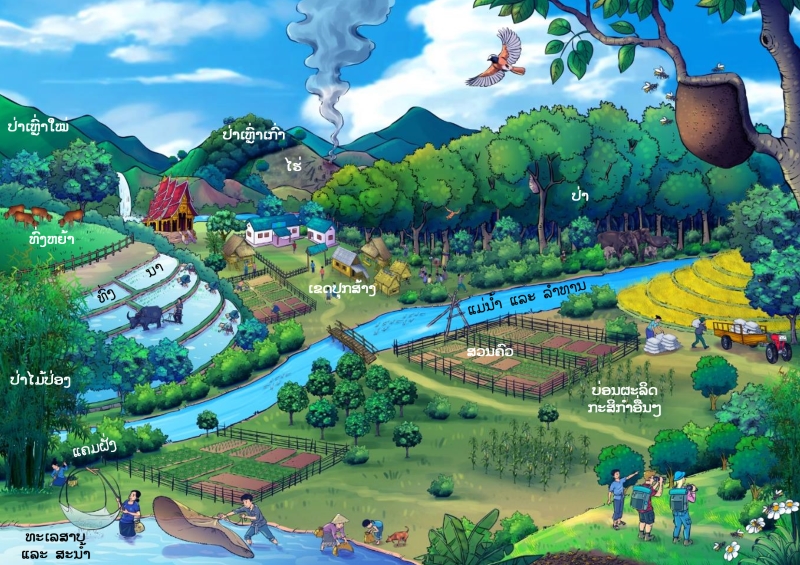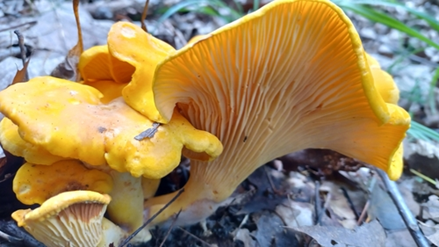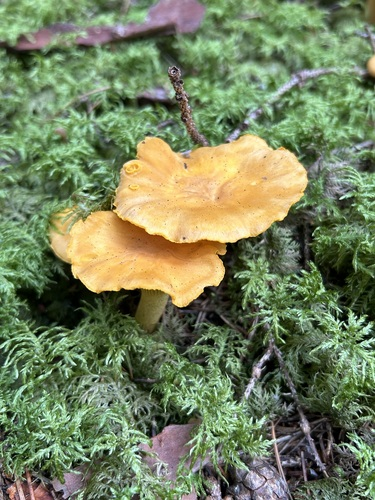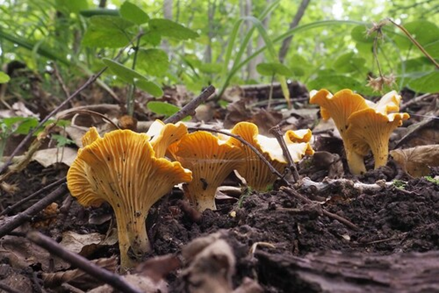ເລກລຳດັບທີ: 124
ລະດັບການຮວບຮວມຂໍ້ມູນ: ເກີອບສົມບູນ
ປັບປູງຄັ້ງລ່າສຸດ: 2024-12-20
ເຫັດແສດໃຫຍ່
Chanterelle
Cantharellus cibarius Fr.
ເຊື້ອເຫັດ
ເຊື້ອຣາທີ່ເກີດຕາມດິນ
×
ຊື່ທ້ອງຖີ່ນ:
( Golden Chanterelle)
ຊື່ພ້ອງ
:
Agaricus alectorolophoides Schaeff.
Agaricus cantharellus L.
Agaricus chantarellus Bolton
Agaricus chantarellus L.
Agaricus chanterellus L.
Alectorolophoides cibarius (Fr.) Earle, 1909
Cantharellus carneoalbus R.Heim
Cantharellus cibarius f. neglectus M.Souché
Cantharellus cibarius f. pallidus (R.Schulz) Anon.
Cantharellus cibarius subsp. albidus Maire, 1937
Cantharellus cibarius subsp. alborufescens Malençon, 1975
Cantharellus cibarius subsp. albus Fr., 1937
Cantharellus cibarius subsp. amethysteus Quél., 1883
Cantharellus cibarius subsp. bicolor Maire, 1937
Cantharellus cibarius subsp. cibarius
Cantharellus cibarius subsp. flavipes R.Heim
Cantharellus cibarius subsp. flavipes R.Heim ex Eyssart. & Buyck, 2000
Cantharellus cibarius subsp. nanus R.Heim, 1960
Cantharellus cibarius subsp. neglectus (Souche) Bigeard & H.Guill.
Cantharellus cibarius subsp. pallidus R.Schulz, 1924
Cantharellus cibarius subsp. rufipes (Gillet) Cooke, 1883
Cantharellus cibarius subsp. salmoneus L.Corb., 1929
Agaricus cantharellus L.
Agaricus chantarellus Bolton
Agaricus chantarellus L.
Agaricus chanterellus L.
Alectorolophoides cibarius (Fr.) Earle, 1909
Cantharellus carneoalbus R.Heim
Cantharellus cibarius f. neglectus M.Souché
Cantharellus cibarius f. pallidus (R.Schulz) Anon.
Cantharellus cibarius subsp. albidus Maire, 1937
Cantharellus cibarius subsp. alborufescens Malençon, 1975
Cantharellus cibarius subsp. albus Fr., 1937
Cantharellus cibarius subsp. amethysteus Quél., 1883
Cantharellus cibarius subsp. bicolor Maire, 1937
Cantharellus cibarius subsp. cibarius
Cantharellus cibarius subsp. flavipes R.Heim
Cantharellus cibarius subsp. flavipes R.Heim ex Eyssart. & Buyck, 2000
Cantharellus cibarius subsp. nanus R.Heim, 1960
Cantharellus cibarius subsp. neglectus (Souche) Bigeard & H.Guill.
Cantharellus cibarius subsp. pallidus R.Schulz, 1924
Cantharellus cibarius subsp. rufipes (Gillet) Cooke, 1883
Cantharellus cibarius subsp. salmoneus L.Corb., 1929
ຊື່ສະກຸນ:
Hydnaceae
ຊະນິດໃກ້ຄຽງ:
ບັນຍາຍລັກສະນະທາງພືດສາດ:
ເຫັດຊະນິດນີ້ມີຂະໜາດປານກາງ ກວ້າງ 20 ຫາ 60 ມມ., ມີສີເຫຼືອງ ຫາເຫຼືອງສົ້ມສະໝ່ຳສະເໝີ, ເຮັດໃຫ້ເບິ່ງສົດໃສ ແລະ ມີຊິວິດຊີວາ.
ກ້ານມີສີເຫຼືອງຈ່າງຈົນຮອດສີຂາວ ໂດຍສະເພາະບໍລິເວໂຄນໃບ, ຜິວກ້ານເຫັດຈະບໍ່ເປື້ອນງ່າຍເມື່ອສຳພັດ ຈຶ່ງເຮັດໃຫ້ຄົງສະພາບເດີມໄວ້ເຖິ່ງແມ່ນວ່າຈະສຳພັດແລ້ວກໍ່ຕາມ.
ໝວກເຫັດດ້ານລຸ່ມມີໂຄງສ້າງແຍກເປັນແຊກ ແລະ ຂວາງກັນຢ່າງຊັດເຈນ ເຊິ່ງທອດຍາວໄປຕາມພື້ນຜິວດ້ານລຸ່ມ ເຊິ່ງເປັນສ່ວນທີ່ຜະລິດສະປໍ. ເມື່ອຍັງອ່ອນໝວກເຫັດຈະມີດອກສີຂາວບາງໆປົກຄຸມ (ມີຊັ້ນຄ້າຍແປ້ງ), ແຕ່ເມື່ອອາຍຸຫຼາຍຂື້ນຈະເລີ່ມຍຸບລົງ (ຍຸບລົງສ່ວນກາງ), ຂອບມວກຈະມ້ວນເຂົ້າເລັກນ້ອຍ ເຊິ່ງໝາຍຄວາມວ່າໂຄ້ງເຂົ້າດ້ານໃນເລັກນ້ອຍ.
ເນື້ອເຫັດມີສີຈືດ ແລະ ແຂງ, ບໍ່ຄືເຫັດຊະນິດອື່ນໆໃນສະກຸນ Craterellus ບ່ອນທີ່ເນື້ອເຫັດຊະນິດນີ້ບໍ່ມີຮູ.
ແຫຼ່ງທີ່ມາ: [1]
ກ້ານມີສີເຫຼືອງຈ່າງຈົນຮອດສີຂາວ ໂດຍສະເພາະບໍລິເວໂຄນໃບ, ຜິວກ້ານເຫັດຈະບໍ່ເປື້ອນງ່າຍເມື່ອສຳພັດ ຈຶ່ງເຮັດໃຫ້ຄົງສະພາບເດີມໄວ້ເຖິ່ງແມ່ນວ່າຈະສຳພັດແລ້ວກໍ່ຕາມ.
ໝວກເຫັດດ້ານລຸ່ມມີໂຄງສ້າງແຍກເປັນແຊກ ແລະ ຂວາງກັນຢ່າງຊັດເຈນ ເຊິ່ງທອດຍາວໄປຕາມພື້ນຜິວດ້ານລຸ່ມ ເຊິ່ງເປັນສ່ວນທີ່ຜະລິດສະປໍ. ເມື່ອຍັງອ່ອນໝວກເຫັດຈະມີດອກສີຂາວບາງໆປົກຄຸມ (ມີຊັ້ນຄ້າຍແປ້ງ), ແຕ່ເມື່ອອາຍຸຫຼາຍຂື້ນຈະເລີ່ມຍຸບລົງ (ຍຸບລົງສ່ວນກາງ), ຂອບມວກຈະມ້ວນເຂົ້າເລັກນ້ອຍ ເຊິ່ງໝາຍຄວາມວ່າໂຄ້ງເຂົ້າດ້ານໃນເລັກນ້ອຍ.
ເນື້ອເຫັດມີສີຈືດ ແລະ ແຂງ, ບໍ່ຄືເຫັດຊະນິດອື່ນໆໃນສະກຸນ Craterellus ບ່ອນທີ່ເນື້ອເຫັດຊະນິດນີ້ບໍ່ມີຮູ.
ແຫຼ່ງທີ່ມາ: [1]
ນິເວດວິທະຍາ
ເຂດກະຈາຍພັນທົ່ວໂລກ:
Native to Albania, Andorra, Armenia, Austria, Belarus, Belgium, Bosnia and Herzegovina, Bulgaria, Croatia, Cyprus, Czechia, Denmark, Estonia, Finland, France, Georgia, Germany, Greece, Hungary, Iceland, Ireland, Isle of Man, Italy, Jersey, Latvia, Liechtenstein, Lithuania, Luxembourg, Malta, Moldova, Montenegro, Netherlands, North Macedonia, Norway, Poland, Portugal, Romania, Russian Federation, Serbia, Slovakia, Slovenia, Spain, Sweden, Switzerland, Türkiye, Ukraine, United Kingdom, Åland Islands. [3]
Global distribution of Cantharellus cibarius best ween 2000 to 2025. Source: [2]
ເຂດກະຈາຍພັນທົ່ວໂລກຂອງເຫັດແສກໃຫຍ່ ລະຫວ່າງປີ 2000 ຫາ 2025. ແຫຼ່ງທີ່ມາ: [2]
Global distribution of Cantharellus cibarius best ween 2000 to 2025. Source: [2]
ເຂດກະຈາຍພັນທົ່ວໂລກຂອງເຫັດແສກໃຫຍ່ ລະຫວ່າງປີ 2000 ຫາ 2025. ແຫຼ່ງທີ່ມາ: [2]
ເຂດກະຈາຍພັນໃນລາວ
:
ເຂດພູສູງສາຍພູຫຼວງ ແລະ ເຂດພູພຽງແຂວງຊຽງຂວາງ

ເຂດກະຈາຍພັນຕາມພູມສັນຖານ
:
ປ່າດົງດິບ
ປ່າປະສົມປ່ຽນໃບ
ປ່າແປກ
ປ່າປະສົມປ່ຽນໃບ
ປ່າແປກ

ສະເພາະຖິ່ນໃນລາວ:
ຕ່າງຖິ່ນ
ຮຸກຮານ
:
ບໍ່ຮຸກຮານ
ສະຖານະພາບການອະນູຮັກ IUCN
:
ມີຄວາມສ່ຽງໜ້ອຍສຸດ
ສະຖານະພາບການອະນຸຮັກແຫ່ງຊາດລາວ
:
ບໍ່ຖືກລະບຸໃນບັນຊີປະເພດໃດ
ການນຳໃຊ້
ປະເພດການນຳໃຊ້:
ອາຫານ
ບັນຍາຍການນຳໃຊ້:
ອາຫານ: ເຫັດຊະນິດເປັນເຫັດທີ່ບໍລິໂພກ ແລະ ຂາຍກັນຢ່າງກ້ວາງຂວາງ ແລະ ເປັນເຫັດທີ່ໄດ້ຮັບຄວາມນິຍົມ, ເຫັດຊະນິດນີ້ຖືກເກັບກ່ຽວພື່ອຈຸດປະສົງທາງດ້ານການຄ້າໃນປະລິມານຂ້ອນຂ້າງຫຼາຍ ແລະ ເປັນໜຶ່ງໃນເຫັດທີ່ເກັບເພື່ອໃຂ້ສ່ວນຕົວຫຼາຍທີ່ສຸດ [3]. ຊາວບ້ານຖືວ່າເຫັດຊະນິດນີ້ເປັນເຫັດທີ່ມີຣົດຊາດແຊບ ແລະ ມັກພົບເຫັນໃນຕະຫຼາດທ້ອງຖິ່ນ. [1]
ການປູກ ການລ້ຽງ:
ຊະນິດທຳມະຊາດ
ລະດູການເກັບກູ້:
ກໍລະກົດ
ສິງຫາ
ກັນຍາ
ຕຸລາ
ພະຈິກ
ທັນວາ
ສິງຫາ
ກັນຍາ
ຕຸລາ
ພະຈິກ
ທັນວາ
ການຕະຫຼາດ ແລະ ຕ່ອງໂສ້ມູນຄ່າ:
N/A
ການຄຸ້ມຄອງຈັດການ
ການອານຸລັກທີ່ຢູ່ອາໄສ:
ໄພຂົ່ມຂູ່: ເຖິ່ງແມ່ນວ່າເຫັດຊະນິດນີ້ອາດຈະຫຼຸດລົງໃນພື້ນທີ່ລະດັບຄວາມສະສົມຫຼຸດລົງ ແຕ່ຍັງມີຫຼາຍພື້ນທີ່ທີ່ຍັງມີລະດັບຈຳນວນປະຊາກອນຫຼາຍຢູ່. [3]
ການຕິດຕາມປະຊາກອນ: ເຫັດຊະນິດນີເປັນເຫັດທີ່ສາມາດພົບເຫັນໄດ້ທົ່ວໄປ ແລະ ແຜ່ຫຼາຍ ແລະ ດ້ວຍເຫດນີ້ປະຊາກອນຈຶ່ງມີຢ່າງໜ້ອຍໝືນຕົວທີ່ຂະຫຍາຍຕົວເຕັມທີ, ດັງນັ້ນ ເຖິ່ງວ່າຍັງບໍຊັດເຈນ ແຕ່ເຮົາຖືວ່າເຫັດຊະນິດນີ້ມີຈຳນວນຫຼຸດລົງ ແຕ່ເຖິ່ງຢ່າງໃດກໍ່ຕາມ ແນວໂນ້ມທົ່ວໂລກຍັງບໍ່ຖືວ່າຈັດຢູ່ໃນກຸ່ມທີ່ຈັດວ່າເປັນຊະນິດທີ່ຖືກຄຸກຄາມທົ່ວໂລກ. [3]
ການເກັບກູ້ແບບຍືຍຍົງ: ໃນບາງພື້ນທີ່ຈຳເປັນຕ້ອງມີຂໍ້ມູນເພີ່ມເຕີມ ເພື່ອທຳຄວາມເຂົ້າໃຈກ່ຽວກັບການຫຼຸດລົງຫຼືບໍ່ຂອງປະຊາກອນໃນກຸ່ມນີ້, ຢ່າງໃດກໍ່ຕາມເນື່ອງຈາກສະຖານະການທົ່ວໂລກຂອງເຫັດກຸ່ມນີ້ເບິ່ງບໍ່ໜ້າເປັນຫ່ວງໃນປັດຈຸບັນ ຈຶ່ງບໍ່ຈຳເປັນຕ້ອງມີການດຳເນີນການອານຸລັກໃດໆໂດຍສະເພາະ. [3]
ໄພຂົ່ມຂູ່: ເຖິ່ງແມ່ນວ່າເຫັດຊະນິດນີ້ອາດຈະຫຼຸດລົງໃນພື້ນທີ່ລະດັບຄວາມສະສົມຫຼຸດລົງ ແຕ່ຍັງມີຫຼາຍພື້ນທີ່ທີ່ຍັງມີລະດັບຈຳນວນປະຊາກອນຫຼາຍຢູ່. [3]
ການຕິດຕາມປະຊາກອນ: ເຫັດຊະນິດນີເປັນເຫັດທີ່ສາມາດພົບເຫັນໄດ້ທົ່ວໄປ ແລະ ແຜ່ຫຼາຍ ແລະ ດ້ວຍເຫດນີ້ປະຊາກອນຈຶ່ງມີຢ່າງໜ້ອຍໝືນຕົວທີ່ຂະຫຍາຍຕົວເຕັມທີ, ດັງນັ້ນ ເຖິ່ງວ່າຍັງບໍຊັດເຈນ ແຕ່ເຮົາຖືວ່າເຫັດຊະນິດນີ້ມີຈຳນວນຫຼຸດລົງ ແຕ່ເຖິ່ງຢ່າງໃດກໍ່ຕາມ ແນວໂນ້ມທົ່ວໂລກຍັງບໍ່ຖືວ່າຈັດຢູ່ໃນກຸ່ມທີ່ຈັດວ່າເປັນຊະນິດທີ່ຖືກຄຸກຄາມທົ່ວໂລກ. [3]
ການເກັບກູ້ແບບຍືຍຍົງ: ໃນບາງພື້ນທີ່ຈຳເປັນຕ້ອງມີຂໍ້ມູນເພີ່ມເຕີມ ເພື່ອທຳຄວາມເຂົ້າໃຈກ່ຽວກັບການຫຼຸດລົງຫຼືບໍ່ຂອງປະຊາກອນໃນກຸ່ມນີ້, ຢ່າງໃດກໍ່ຕາມເນື່ອງຈາກສະຖານະການທົ່ວໂລກຂອງເຫັດກຸ່ມນີ້ເບິ່ງບໍ່ໜ້າເປັນຫ່ວງໃນປັດຈຸບັນ ຈຶ່ງບໍ່ຈຳເປັນຕ້ອງມີການດຳເນີນການອານຸລັກໃດໆໂດຍສະເພາະ. [3]
ໂພຊະນາການ
ຄຸນຄ່າທາງໂພຊະນາການ:
ບັນຍາຍຄຸນຄ່າທາງໂພຊະນາການ:
N/A
| ສານອາຫານ | /100g | ໝາຍເຫດ |
|---|---|---|
| ໂປຣຕີນ | N/A | N/A |
| ຄາໂບໄຮເດຣດ | N/A | N/A |
| ໄຂມັນ | N/A | N/A |
| ວິຕາມິນ | N/A | N/A |
| ແຮ່ທາດ | N/A | N/A |
| ເສັ້ນໄຍ | N/A | N/A |
ອ້າງອິງ
ເຄດິດຮູບພາບ:
Cantharellus cibarius mushroom gill characteristics. [1] iNaturalist [Online]. Uploaded on 12 July 2024 by: ana_ng57. Available: https://www.inaturalist.org/photos/406199896. [Accessed: 05 October 2024]
Cantharellus cibarius from above. [2] iNaturalist [Online]. Uploaded on 19 July 2024 by: mani_raab. Available: https://www.inaturalist.org/photos/409251059. [Accessed: 05 October 2024]
Group of Cantharellus cibarius in natural. [3] iNaturalist [Online]. Uploaded on 23 July 2024 by: igor_scherbakov. Available: https://www.inaturalist.org/photos/410663671. [Accessed: 05 October 2024]
Cantharellus cibarius from above. [2] iNaturalist [Online]. Uploaded on 19 July 2024 by: mani_raab. Available: https://www.inaturalist.org/photos/409251059. [Accessed: 05 October 2024]
Group of Cantharellus cibarius in natural. [3] iNaturalist [Online]. Uploaded on 23 July 2024 by: igor_scherbakov. Available: https://www.inaturalist.org/photos/410663671. [Accessed: 05 October 2024]
ອ້າງອິງ:
[1] T. Laessoe, & et al., “An Introduction to the Edible, Poisonous and Medical Fungi of Northern Laos,” Agro-Biodiversity Project, 2018
[2] Global Biodiversity Information Facility (GBIF), “Cantharellus cibarius Fr.,” [Online]. Available: https://www.gbif.org/species/5249504. [Accessed: 05 October 2024]
[3] IUCN, “Rainbow Chanterelle (Cantharellus rainbow),” IUCN Red List of Threatened Species, [Online]. Available: https://www.iucnredlist.org/species/195922611/195927637. [Accessed: 31 July 2024]
[4] "Chanterelle," Mushroom Collecting, [Online]. Available: http://mushroom-collecting.com/mushroomchanterelle.html. [Accessed: Apr. 3, 2025].
[2] Global Biodiversity Information Facility (GBIF), “Cantharellus cibarius Fr.,” [Online]. Available: https://www.gbif.org/species/5249504. [Accessed: 05 October 2024]
[3] IUCN, “Rainbow Chanterelle (Cantharellus rainbow),” IUCN Red List of Threatened Species, [Online]. Available: https://www.iucnredlist.org/species/195922611/195927637. [Accessed: 31 July 2024]
[4] "Chanterelle," Mushroom Collecting, [Online]. Available: http://mushroom-collecting.com/mushroomchanterelle.html. [Accessed: Apr. 3, 2025].
ຜູ້ສ້າງ Factsheet:
ຜູ້ກວດສອບ Factsheet:
,


